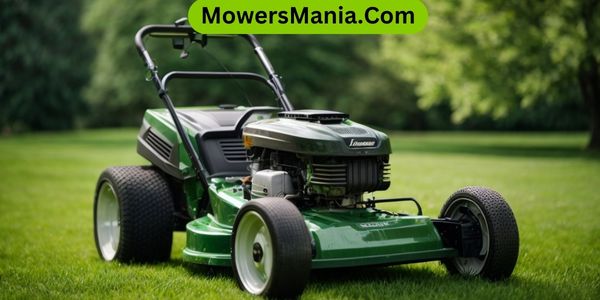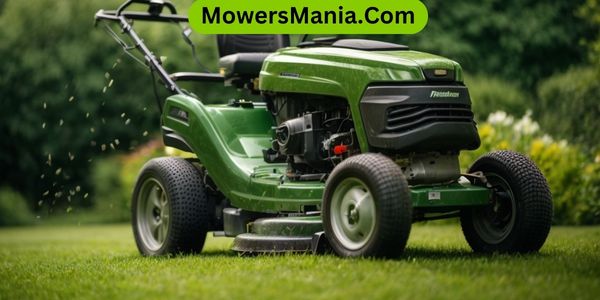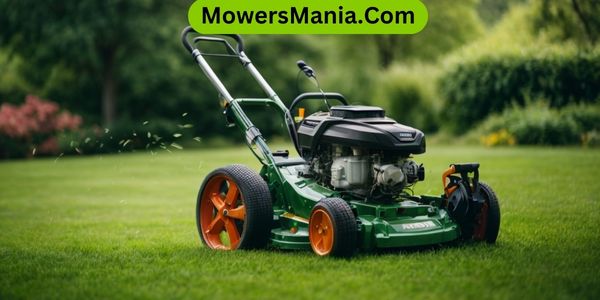Do you ever wonder how your lawn mower actually works? Well, get ready to find out! In this article, we’ll break down the inner workings of lawn mowers, from the engine that powers it to the blade assembly that cuts the grass.

You’ll also learn about the fuel system, drive system, and safety features that keep you protected.
So, let’s dive in and explore how lawn mowers work!
How Does A Lawn Mower Work?
1. The Engine
Now let’s explore the engine of a lawn mower and how it powers the cutting blades to efficiently maintain your lawn.
The engine of a lawn mower is the heart and soul of its functionality. It’s responsible for generating the power needed to rotate the blades and cut through the grass with ease.
The engine typically runs on gasoline, which is stored in a fuel tank located on the mower. When you start the mower, the engine ignites the gasoline using a spark plug, creating a controlled explosion that moves the piston up and down.
The movement of the piston, in turn, rotates the crankshaft, which transfers power to the cutting blades. This process happens rapidly, resulting in a continuous rotation of the blades, allowing them to effectively trim the grass as you push or ride the mower.
The engine’s power empowers you to effortlessly upkeep your lawn, leaving behind a pristine and immaculate visage.
2. The Blade Assembly
To effectively maintain your lawn, the blade assembly of a lawn mower plays a crucial role in cutting and trimming the grass with precision and efficiency. The blade assembly consists of several key components that work together to ensure a clean and even cut.
At the heart of the assembly is the cutting blade itself. Made from durable and sharp steel, it spins rapidly when the engine is running, slicing through the grass with ease. The blade is attached to the blade shaft, which is connected to the engine’s crankshaft. As the crankshaft rotates, it transfers power to the blade, causing it to spin.
The blade assembly also includes a cutting deck, which houses the blade and provides a protective housing for the spinning blade. The deck is designed to create an even airflow, which helps to lift the grass blades for a more precise and uniform cut.
Additionally, the blade assembly may feature a height adjustment mechanism, allowing you to set the cutting height according to your preferences. This ensures that you can achieve the desired length for your lawn.
3. The Fuel System

The fuel system of a lawn mower consists of various components that work together to deliver the necessary fuel to the engine for efficient operation.
One of the key components of the fuel system is the fuel tank, which holds the gasoline or fuel mixture. It’s usually located at the rear of the mower and has a fuel cap that needs to be securely tightened to prevent any fuel leakage.
From the fuel tank, the fuel is transferred to the carburetor through a fuel line. The carburetor plays a crucial role in the engine’s performance. It skillfully blends fuel with air, forming a highly flammable combination that can be easily ignited by the spark plug. Moreover, it adeptly adjusts the fuel flow within the engine, precisely aligning it according to the throttle position set by the user..
The carburetor also contains a float bowl, which helps maintain a constant fuel level.
In addition to the carburetor, the fuel system also includes a fuel filter to prevent any debris or particles from entering the engine. It’s important to regularly clean or replace the fuel filter to ensure proper fuel flow and prevent any engine damage.
4. The Drive System
To engage the drive system of your lawn mower, simply push the lever forward. The drive system is responsible for propelling the mower forward, allowing you to effortlessly maneuver around your yard.
When you push the lever forward, it engages the drive belt, which transfers power from the engine to the wheels. This power is generated by the engine’s combustion process and is transmitted through a series of gears or a hydrostatic transmission.
The drive system also includes a clutch, which allows you to disengage the drive and manually push the mower if needed.
There are different types of drive systems available for lawn mowers. Some mowers have a self-propelled drive system, where the wheels are powered by the engine and move the mower forward automatically.
Others have a push drive system, where you have to manually push the mower to move it. Additionally, some mowers have variable speed drive systems, which allow you to adjust the speed at which the mower moves.
It’s important to maintain the drive system of your lawn mower to ensure optimal performance. Regularly check the drive belt for wear and replace it if necessary.
Keep the gears lubricated and inspect them for any signs of damage. By taking care of your mower’s drive system, you can enjoy a smooth and efficient mowing experience.
5. The Safety Features

As you engage the drive system of your lawn mower, it’s important to be aware of the safety features in place. These features are designed to protect you and others from potential accidents and injuries while operating the mower.
One of the most important safety features is the blade control system. This system ensures that the blades of the mower only spin when you want them to. It prevents the blades from spinning when you release the blade engagement lever or when the mower is in reverse. This feature helps to prevent accidental cuts and injuries.
Another crucial safety feature is the dead man’s switch. This switch automatically stops the mower’s engine and blades when you release the handle. It acts as a kill switch, instantly stopping the mower if you lose control or let go of the handle.
Additionally, many modern lawn mowers also come with safety shields or guards. These shields cover the blades and prevent debris from being thrown out during operation, reducing the risk of injuries to yourself or others nearby.
It’s important to always check that these safety features are in good working condition before you start mowing your lawn. By being aware of and utilizing these safety features, you can enjoy a safer and more worry-free mowing experience.
Frequently Asked Questions [FAQs]
What Are the Different Types of Lawn Mowers Available in the Market?
There are various types of lawn mowers available in the market. You can choose from push mowers, self-propelled mowers, and riding mowers, depending on your needs and the size of your lawn.
How Often Should the Oil Be Changed in a Lawn Mower Engine?
You should change the oil in your lawn mower engine regularly. Neglecting this maintenance can lead to engine damage. Follow the manufacturer’s recommendations for the specific model you own.
Can a Lawn Mower Be Used on Uneven Terrain or Slopes?
Yes, a lawn mower can be used on uneven terrain or slopes. However, it is important to exercise caution and follow the manufacturer’s guidelines to ensure safe and effective mowing.
What Should Be Done if the Lawn Mower Starts Smoking Excessively?
If your lawn mower starts smoking excessively, stop using it immediately. Turn off the engine and let it cool down. Check for any debris or clogs. If the problem persists, consult a professional for repairs.
Are There Any Specific Maintenance Tips for Storing a Lawn Mower During the Winter Months?
To properly store your lawn mower during winter, make sure to drain the fuel, clean the deck, and remove the spark plug. It’s also a good idea to store it in a dry and sheltered area.

Conclusion
So next time you see a lawn mower in action, you’ll have a better understanding of how it works.
From the engine powering the blades to the fuel system supplying it with energy, every component plays a vital role.
Not to mention the drive system that propels the mower forward and the safety features that keep you protected.
Now you can appreciate the complexity behind this seemingly simple machine that keeps our lawns looking neat and tidy.



